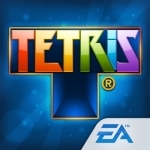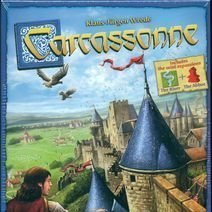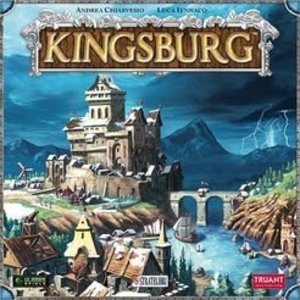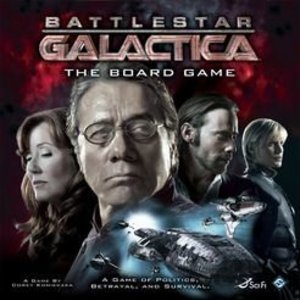
TETRIS® Premium for iPad
Games
App
Rediscover the world-famous Tetris® game you know and love, with all-new features and boundless...

The Master Tactician Pro: Soccer Coach
Sports and Utilities
App
Features: • Used by several teams in the English League • Developed with Dean Holdsworth and his...

Jaipur
Tabletop Game
Jaipur, capital of Rajasthan. You are one of the two most powerful traders in the city. But...
Boardgames Cardgames FamilyGames

The Princes of Florence
Tabletop Game
A new game for all great strategists! Experience the golden age of the Renaissance! Assume the role...
Boardgames AuctionGames

Carcassonne
Tabletop Game
Carcassonne is a tile-placement game in which the players draw and place a tile with a piece of...
GatewayBoardgames

Kingsburg
Tabletop Game
In Kingsburg, players are Lords sent from the King to administer frontier territories. The game...
Boardgames WorkerPlacementGames

Jambo
Tabletop Game
From the back of the box: "Jambo is the friendly greeting Swahili traders offered their customers...
2playergames KosmosGames DornGames AfricanGames Cardgames

Artisans of Splendent Vale
Tabletop Game
Long ago, a splendid streak of crimson fell from the sky and carved the valley from the earth. The...
Purple Phoenix Games (2266 KP) rated MechaTop in Tabletop Games
Jul 2, 2020
Disclaimer: We were provided with a PnP version of this game for the purposes of this preview. Please excuse my lack of a color printer, and rest assured that the cards are colorful and eye-catching. The rulebook we have is not the finalized version, but rather an up-to-date draft detailing the overall rules and gameplay. Some changes will probably take place during the Kickstarter campaign, so the finalized game system might have some differences to this preview. For more details, check out the publisher’s website! -L
MechaTop is a tabletop wargame system in which players pilot large Mecha suits and battle their opponents. To begin a game, you must first decide which game mode you want to play. After selecting the game mode, players create their Mecha teams for battle. Each game mode has an associated cost score limit – the highest maximum cost you can spend on your team. For example, a Mecha suit might cost 300, and the cost score limit for the chosen mode is 600, leaving you with 300 to spend on upgrade cards for your suit. Once all players have chosen and upgraded their Mecha suits, those corresponding cards are placing in their play area. Everyone then selects a Pilot card to be assigned to their Mecha suit, and receives a set of Button tokens and a secret Twist card (kept secret until played at any time during the game). Decide which weapons to equip on your suit for the start of the game, roll a d6, and take turns placing your Mecha in the playing field in ascending numerical order of the die rolls. You are officially ready to start the game now!
Each round begins with the Instinct Phase, where players decide which 2 Button tokens they want to play this round. The Button actions are: Attack, Movement/Rotation, Change Weapon/Reload, and possibly Telekinesis. After the Buttons have been selected, they are placed face-down on the playing field next to their corresponding Mecha suit. Next is the Initiative Phase, in which all players roll a d6 and the player who rolled the highest gets to act first in the round. On your turn, you may choose to activate 1 Button token, activate both Button tokens, or declare No Action and pass your turn. Choosing to activate only 1 Button allows you to perform a simple action, but activating both at the same time in certain combinations allows you to perform a more powerful type of the corresponding action. Choosing to do No Action allows you to keep both Button tokens facedown. The benefit to leaving either 1 or both Button tokens facedown is that you can then use them as reactions during an opponent’s turn. Let’s say an opponent tries to Attack you – if you have your Movement Button still at your disposal, you can use it to attempt to dodge the hit and negate that damage. If you don’t use a Button in that situation, or don’t have one left face-down, all the damage goes straight through on your suit, thus bringing you closer to losing the game. Be warned – some actions are automatic, but some are resolved by dice rolls, so you better hope luck is on your side! After all players have had a turn in Initiative Order, a new round begins with another Instinct Phase. Play continues in this manner until the win condition of the selected game mode has been met, and the winner is deemed victorious!
First and foremost, I think one of the coolest things about the MechaTop system is that it can be played using ANY mecha models, action figures, or standees that you choose. In my childhood, Transformers made up a decent amount of our household, so it’s neat that I am able to bring those back out again after all these years. The nostalgia is great in that sense, and it makes the game more enjoyable. Also along those lines, the game will come with blank Mecha and Pilot cards for you to create your own – the rulebook has a section dedicated to stat card creation. It’s a neat element that lets you add a personal twist to your game, and lets you sit in the pilot’s seat (see what I did there?) to make the game truly your own! In the team creation step, players also have the opportunity to buy Upgrades for their suits, and that gives you additional control over your game. You can create so many different combinations of Upgrades that keep each game unique and entertaining.
The overall game flow is pretty nice. The rounds are logical, and the Button tokens add a unique element of strategy that takes this game to the next level for me. Do you forego doing a special action this turn and save a Button token in case an opponent tries to attack you? Or are you willing to risk damage to your Mecha suit in order to execute the exact plan that you want? The Button tokens take MechaTop beyond a simple attack-and-defend wargame and incorporates strategy to help balance out the randomness of Initiative rolls. The Twist cards are a nice touch as well, because if played at the right time, they could literally turn the battle around for you! No matter how good your strategy is, however, all offensive/defensive actions are dictated by dice rolls. So there’s a bit of a luck element embedded in this game as well. You have to be able to adapt your strategy on the fly depending on how your die results are turning out!
There is a bit of a learning curve to this game that can make it seem daunting at first. Different actions require a different number of dice to roll, and knowing what results counts as a success or failure is not always easy to remember. Incorporating a Player Reference Sheet would eliminate some of the confusion, but it does get easier to remember the more you play the game. Probably the biggest drawback of the system for me is that there is no set game board or movement system. The rulebook details movement speeds and weapon ranges based on different scales of models you might use, but that honestly just went right over my head. Providing a set of bases for models, as well as a hex-grid board would take out that guess-work for players and make it easier to visualize movement and range. And that would help keep the game flowing smoothly because players would not have to spend time measuring distances across the play area.
Let’s talk components. As I mentioned earlier, we only have a PnP copy of MechaTop, so admittedly our components are not the best. That being said, the finalized game should be coming with nice colorful cards, sturdy cardboard tokens, and good quality dice. Don’t let my drab version keep you from checking out the game on BGG or its own website!
All in all, MechaTop is a wargame system that I can see myself playing again. The gameplay itself is straight-forward and simple to grasp, but the strategic elements incorporated with Button tokens, Twist cards, and Upgrades ensure that you will never play the same game twice. If you’re looking to get into wargame systems, or are just looking for a unique wargame setting, definitely check out the MechaTop Kickstarter when it goes live later this month!
Purple Phoenix Games (2266 KP) rated Battlestar Galactica: The Board Game in Tabletop Games
Feb 23, 2021
Disclaimer: There are several expansions for Battlestar Galactica. This review will not take any expansions into account, and will focus solely on the base game. Also, I do not intend to rehash the entire rulebook in this review, but rather provide an overview of the gameplay. – L
To setup for a game, follow the instructions in the rulebook – there are simply too many to detail here. Each player selects a Character, and receives the corresponding Character sheet and tokens. Based on the Characters selected, one player will receive the President title and another the Admiral title. Depending on how many players there are, a Loyalty deck is created and each player is secretly dealt a Loyalty card – either “You are not a Cylon” or “You Are a Cylon.” The Loyalty cards determine how you will play the game: human players win if they complete their given objective, and Cylon players win if they prevent the humans from completing their objective (by depleting resources, successfully invading the Galactica, or destroying the Galactica itself). The game is now ready to begin!
Battlestar Galactica is played over a series of rounds in which players take turns moving, performing actions, playing/drawing cards, etc. until either the human players or Cylon players have won the game. A player’s turn consists of 4 main steps, carried out in the following order: Receive Skills, Movement, Action, and Crisis. To begin your turn, you will draw Skill cards according to the skills listed on your Character sheet. Skill cards can be used to address crises or can provide special abilities. In the next step, Movement, you may move your Character to a different location/ship (all provide special actions). After moving, you will then choose one Action to perform – either listed on your current location, Character sheet, by using a Skill card, or you may choose to perform no action at all. Once you have completed your action, draw the top card of the Crisis deck, and resolve it. Depending on the Crisis card drawn, you may need to then Activate Cylon Ships or Prepare for Jump (more on this in a bit). If neither of those are listed on the Crisis card, then your turn ends and play moves to the next player.
I know that seems like a lot, but each turn of Battlestar Galactica can essentially be broken down into 2 phases: Player Actions and Space Combat. The first phase, Player Actions, is what is detailed above – drawing Skills, Movement, Actions, and drawing Crisis cards. This phase is where players make progress towards their objectives. Certain Actions or Skill cards earn specific rewards necessary to move forward in the game. Crisis cards can consist of Cylon attacks (activating and adding new Cylon ships to the board), Skill checks (all players secretly contribute Skill cards to either aid or sabotage the Skill check), or Events (resolved immediately). The second phase of play, Space Combat, takes place after the Crisis card has been drawn on each turn. Certain Crisis cards will show icons of Cylon ships, indicating that they are to be activated for combat, launched into play, or moved around the Galactica. Cylon ships will act based upon an action hierarchy, detailed in the rulebook. If the drawn Crisis card has the “Prepare for Jump” icon, move the fleet token forward on the Jump Preparation track, jumping the fleet if necessary (and moving the humans closer to their game-end objective). I have purposefully left out some elements of play, for you to discover on your own, or because they just provide intricate detail for the steps and actions described above. When the game-end objective is met by either the human players or the Cylons, the game is over and that respective race wins the game!
To say that there is a lot going on in Battlestar Galactica is quite an understatement. There are several rules and game elements that I did not touch upon, just because if I did then this review would be too long. With so many elements in play and of which to keep track, this game is not exactly for the faint of heart. The gameplay is very involved and requires a good amount of strategy – this is definitely a game that could take up most of a game night to play. That being said, I love this game. There is a lot going on, but that just provides players with so many different strategies to complete their objectives. Maybe you want to focus on dealing with Skill checks or Crisis cards, but maybe you’d rather think offensively and be prepared for any potential Space Combat. Can you help the crew efficiently manage its resources, or position its fleet to protect the Galactica itself? Your strategy must be adaptable at a moment’s notice to help you complete your objective….whatever it may be.
Speaking of which, the fact that there may or may not be secret Cylon players attempting to disrupt your plans really takes a hidden identity game to the next level. Cylons want to sabotage the humans, but in subtle ways as to not be found out – because once a Cylon is revealed, the humans can target and hinder their turns. Can you convince the humans that your previous actions were honest mistakes, or will they catch on that you are trying to undermine their efforts? The elements of deception and bluffing in this regard make the game much more immersive and make it feel realistic – there is a traitor among us and we have to find them, while also completing our own objectives. You really start to question who to trust and how your own actions can be perceived by your fellow players. There have been times, when playing this game, that we have taken breaks for dinner or snacks, and all players pocketed their cards rather than leave them on the table, vulnerable to sneaky opponents. Battlestar Galactica is definitely engaging for all players, and for such an involved and lengthy game, that is something to be applauded.
Let’s touch on components for a minute. The production quality of this game is great. The cardboard elements, including resource dials, are thick and sturdy. The cards and Character sheets are quality, colorful, and feel good in hand. And the plastic ships are well made too. The artwork consists mainly of screen caps from the TV show (which I admittedly have not yet seen…) but the theme and cohesiveness of the components makes for an immersive and engaging game overall.
In general, I am not a person who enjoys hidden identity games – simply because I am a bad liar and get found out almost immediately. However, the way this mechanic is incorporated into Battlestar Galactica makes it more a game of strategy than simple deception. And games of strategy are what I truly love. Managing your hand of Skill cards to best overcome Crisis cards, thinking tactically about how to deploy your fleet and battle Cylon ships, and having to determine who among the crew can actually be trusted keeps all players engaged across the board. Nobody can just sit back and relax, every single turn can drastically affect the outcome of the game. Everyone is in it, and that is what I love about this game. Purple Phoenix Games gives it a 11 / 12. This game has been out of print for a while now, but if you ever get a chance to play – jump on it! You don’t have to know the show to enjoy the game. Trust me, I haven’t seen a single episode yet.

